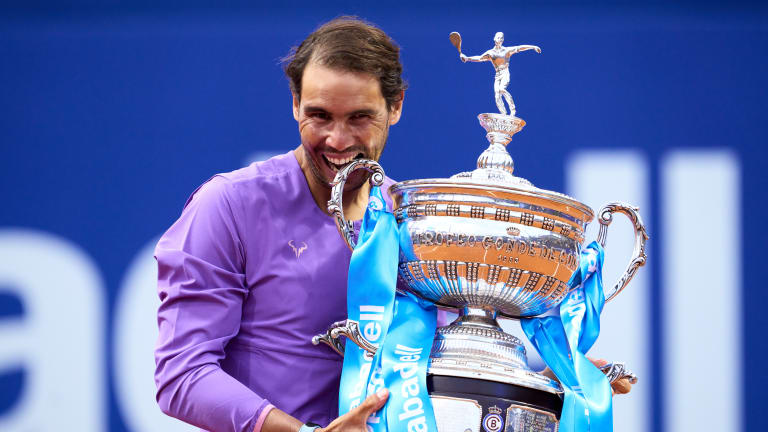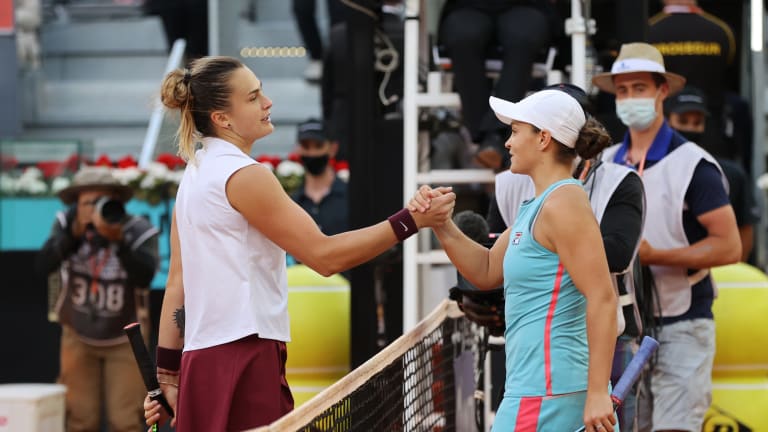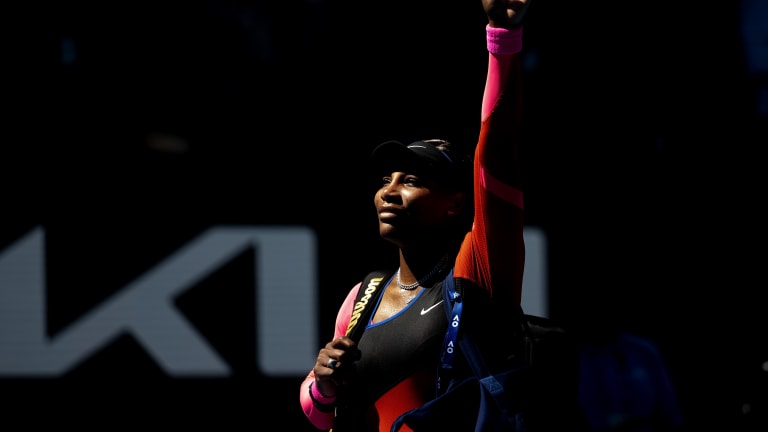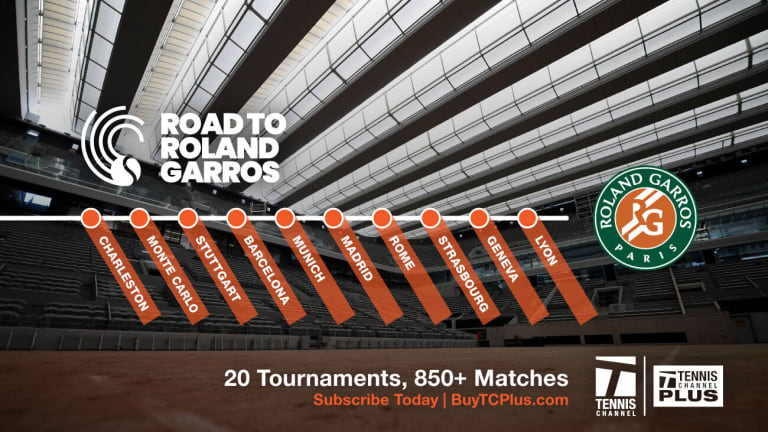The Rally: Sliding into the clay swing as Roland Garros looms
By Joel Drucker and Steve Tignor May 10, 2021Debating best-of-three sets vs. best-of-five
By Steve Tignor May 21, 2021The Tennis Conversation: Tim Henman
By Matt Fitzgerald May 21, 2021The Pick: Lorenzo Musetti vs. Sebastian Korda, ATP Lyon second round
By Cale Hammond May 18, 2021In Geneva, Roger Federer loses clay-court comeback to Pablo Andujar
By John Berkok May 18, 2021The Pick: Jannik Sinner vs. Aslan Karatsev, ATP Lyon first round
By Cale Hammond May 17, 2021Officials deny that 2022 Australian Open could move
By Kamakshi Tandon May 17, 2021Week in Preview: Serena, Federer lead stars tuning up for French Open
By Steve Tignor May 17, 2021Nadal finds the final answer for Djokovic in roller coaster Rome final
By Steve Tignor May 16, 2021Rafael Nadal battles past Novak Djokovic to win Rome for 10th time
By John Berkok May 16, 2021The Rally: Sliding into the clay swing as Roland Garros looms
Dirtball Edition: Steve Tignor and Joel Drucker discuss instant replay coming to clay; how Ashleigh Barty has raised the stakes this spring; whether we should ever doubt Rafa; Serena’s Rome return, and more.
Published May 10, 2021
Advertising
Hi Joel,
With Madrid just finished and Rome just starting, this seems like a good moment to take stock of what we’ve seen so far during the clay season. I’ll begin by noting that, for me, one of the highlights of Madrid is seeing the camera linger on a face in the crowd, knowing it’s someone famous—usually a footballer—and yet having no idea who it is. For some reason I find this liberating. Maybe it’s because I’m not forced to have an opinion one way or another on this person, the way we are with our own celebrities in the States.
To get back to tennis, let me throw out a clay-swing few topics that seem worthy of discussion.
Instant replay on dirt: Many around the game have called for it, and this past week we saw it in action in the main stadium in Madrid. For a long time, I thought there was no reason to leave the traditional ball-mark system behind. But as Hawk-Eye and FoxTenn grew to be accepted as the last word on line calls, I came around to the idea. It seems strange to me now to watch players and umpires inspect the surface and argue over marks, while those of us at home get to see the official verdict from Hawk-Eye or FoxTenn—the latter of which was used on a trial basis in Madrid. How did you think it worked this week? I saw a few complaints from players, but no glitches that would disqualify the system in the future.

The Rally: Sliding into the clay swing as Roland Garros looms
© Getty Images
Advertising
Getty Images
Next Gen vs. Old Gen: It’s a spring-tennis tradition—Rafael Nadal loses a match or two in the run-up to Roland Garros, we wonder for a few minutes if he’s finally in decline on dirt, and then he rolls through Paris without dropping a set. Right now, after Rafa’s one-sided loss to Alexander Zverev in Madrid, some of us are in the wondering phase again. On the one hand, his 13 titles at Roland Garros shows that it’s stupid ever to doubt him; on the other hand, he’s probably going to lose there one of these years. But until that actually happens, you have to pick him to win.
The better question might be: Is there anyone who is ready to beat him? Djokovic is still the most likely, though he has done little so far during the clay season. This has been a good stretch for the Next Gen, with Zverev and Stefanos Tsitsipas winning Masters titles in Madrid and Monte Carlo, and Andrey Rublev and Matteo Berrettini making finals. But their success continues to come in short waves; none of them has ridden one all the way in. What do you think, Joel, is there any reason to believe this is the year when Nadal and Djokovic finally fail to rise to the Grand Slam occasion?
Barty-Sabalenka: I’m liking this budding rivalry, in part because it’s an extreme contrast in style and personality, and in part because they tend to play close matches. I find Barty a calming player to watch; she doesn’t need to do anything other than go about her business and show off her easy athleticism to be entertaining. As for Sabalenka, I didn’t always enjoy her whiplash-inducing dips in form, but I’m liking her new consistency. She has the shots, and the expressiveness, of a star.
Tell me what you think of these or any other clay-season topics, Joel.
Hi Steve,
Indeed, how great to see the European clay court season in full swing. No period in the tennis year is as visually compelling. From the Mediterranean alongside Monte Carlo, to the orange of the clay, to seeing such icons as Manuel Santana and Ion Tiriac in Madrid, to what’s to come in Rome and Paris—and of course, to the wide range of players from so many countries—this is the time when tennis’ global significance is most visible.
As far as the tennis goes, how great to finally have challenges on clay. Why not? As you noted, not many hitches at all.

The Rally: Sliding into the clay swing as Roland Garros looms
© Getty Images
Advertising
Getty Images
When it comes to dethroning King Rafa, I think the nature of tennis makes it impossible to ponder the player who will topple a clay court dominator. Recall the Roland-Garros empires of seven-time champion Chris Evert and six-time winner Bjorn Borg. As the saying goes, tennis is a game of errors, and during their years at the top, neither Evert nor Borg seemed to make any on the clay. Though the Nadal era has a whole different level of technology and physicality, the premise of relentless consistency remains. Like Evert and Borg, Nadal at Roland-Garros is impregnable. I’ll steal from my own 2019 tweet:
As they surely will, space invaders will arrive on Earth to claim our planet. But first, their designated tennis player must try and beat Nadal at Roland-Garros. If the invader wins, I will board the ship.
Though I suspect the time will come when Nadal will cease to win at Roland-Garros, I also know that to do so now will require an effort that’s both extraordinary and unprecedented. That’s a pretty rough combination. And with it being so hard to imagine such a space invader, when it comes to men’s tennis, I find myself primarily enjoying matches one at a time, rarely investing energy in the fate of specific players. Sure, Rublev beat Nadal in Monte Carlo. Tsitsipas nearly did that in Barcelona. Then came Zverev in Madrid. All great players. But still, I’d be foolish to dare say they now have all it takes to beat Nadal in Paris.
So while I can’t picture seeing Nadal toppled (though of course it can happen), the WTA is quite a vivid showcase. There’s just a great range of styles in the mix that will make for some great tennis. Start by simply considering the last three champions—Iga Swiatek, Ashleigh Barty, Simona Halep. Add in Naomi Osaka, Aryna Sabalenka, Petra Kvitova, Serena Williams, Karolina Pliskova, Jennifer Brady, Sofia Kenin. That’s a lot of range, with tons of intriguing matchups and tactics.
Of those women, Steve, which matchup would you most like to see?
Joel,
The women’s game right now has as much variety as I can remember. Each month it seems as if there’s another name added to the list of title contenders. But a big part of the tour’s appeal for me this spring has been seeing one player, the No. 1 player, Ashleigh Barty, out there every week, and getting herself deep into tournaments most of those weeks.
This is partly due to the pandemic; Barty can’t easily travel in and out of her home country, Australia. But whatever the reason is, it has had a salutary effect on the sport as a whole, at least for me. There’s something about seeing the world No. 1 in every draw, and in most finals, that raises the stakes and significance of those events, and trickles down to the rest of the matches. It’s like the old Virginia Slims days, when Chris and Martina would do battle on a weekly basis, and you didn’t have to wait until the Slams for the results to count. Hopefully, Barty enjoys her time on the road and stays on it even when the pandemic is over.

The Rally: Sliding into the clay swing as Roland Garros looms
© Getty Images
Advertising
Getty Images
As I said above, I’ve enjoyed the mini-rivalry that has kicked up between Barty and Sabalenka. I’ve enjoyed watching Swiatek and Coco Gauff even when they haven’t played well, because there’s a sense with each of them that they’re still learning from each loss. I’ll be interested to see if Naomi Osaka can master the soft-court game the way she has the hard-court game; how Sofia Kenin fares without her father; and whether Jessica Pegula can transfer her hard-court success to clay and grass. After Miami, I really want to see Bianca Andreescu compete again; there are few who do it as fiercely or as well as she does. And Simona Halep and Garbiñe Muguruza will always be favorites for me, because of how much emotion, and desire to win, they show each time they play.
What’s interesting right now is how much variety there is among the Next Gen on the men’s tour. Djokovic and Nadal still reign supreme in the rankings and the Grand Slams, but they haven’t been the stars of the clay season. Instead it has been Tsitsipas, Rublev, Zverev, and Berrettini—as well as Jannik Sinner in Miami—who have made the finals and the headlines. So far, these guys are still jockeying for position; I wonder if that’s how it will continue to be even when Djokovic and Nadal are gone, or if one of them will rise above the others. Right now, I have no idea who that might be.
Joel, both Rome draws are loaded, and with Roland Garros one more week away than normal, this tournament feels like it has an added significance all its own. What are you looking forward to seeing at the Foro?
Steve,
When it comes to players of interest in Rome, we’ll start with two icons: Novak Djokovic and Serena Williams. Djokovic lost earlier than usual in Monte Carlo and Belgrade. But he won the title in Rome last fall and it’s reasonable to expect him to go the distance again. Djokovic’s opening match will be versus Taylor Fritz, the big-serving American who extended him to five sets earlier this year at the Australian Open.
With Williams, the thinking is different. The last time she played was in February, losing in the semis of the Australian Open to Osaka. But we know that Serena’s been training hard on the clay. While a title run in Rome would be amazing, I’m less intrigued by that potential outcome and more curious about her process. Serena’s movement in Australia was superb. Will that continue on clay? And, much like Roger Federer, how will Serena’s mix of movement, skills and experience keep her healthy enough for a solid effort at Roland-Garros? Down the road, what might that bode for her best Slam shot, Wimbledon?

The Rally: Sliding into the clay swing as Roland Garros looms
© Getty Images
Advertising
Getty Images
The Barty-Sabalenka rivalry is shaping up quite nicely—a wonderful contrast of personalities and playing styles. Their recent finals in Stuttgart and Madrid were terrific. In Rome, they’re on a path to meet in the quarterfinals.
Another early round Rome match I can’t wait to see: Tuesday’s between Madison Keys and Sloane Stephens, who is in as a lucky loser following the withdrawal of Madrid quarterfinalist Karolina Muchova. Spicing it up is that the winner of Stephens-Keys will play Iga Swiatek.
Then there’s another compelling early matchup: Jannik Sinner versus Nadal. Last week in Madrid, Nadal played a rising Spaniard, Carlos Alcaraz, and beat him handily. Now it’s time for Sinner—an Italian in Rome, taking on the king of clay. Sinner is much further along in his tennis development than Alcaraz, so this figures to be much more competitive.
Finally, I’ve always found it exciting to watch a late-stage night match from Rome. The lights bouncing off the clay, the players bringing their all, the vocal crowd—just a spectacular, high-energy prelude to Roland Garros.

The Rally: Sliding into the clay swing as Roland Garros looms